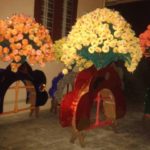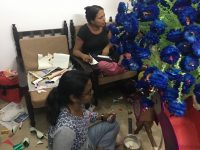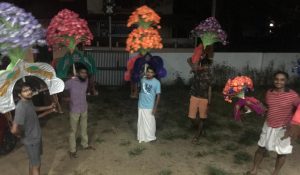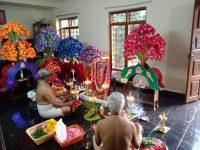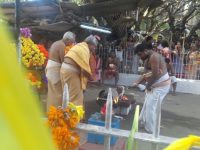Pooyam 2022
Pooyam Pooja
Subrahmanya Seva & Thaipooyam
Lord Subrahmanya the God of this era like Lord Ayyappa was worshiped by our forefathers along with other Deities. With devotion the traditions were followed by the generations. Two significant rituals celebrated in the family dedicated to Lord Subrahmanya are Panaka pooja & Thaipooyam.
Panaka Pooja to Lord Subrahmanya is performed on the Sashti, the sixth tithi of the waxing and waning phase of the moon preceding Thaipooyam. The family members doing the pooja and carrying the kavadi, adorn a chain and observe 10 days penance/vratham by strict vow of abstinence, celibacy and having satvik food.
During panaka pooja, Vel Abhisheka (anointing of lances (Vel) with several offerings) is performed. The Vel symbolizes true knowledge, the need for devotees to invoke the Siva-Shakti force within them and the grace of Lord Subrahmanya. Vel awakens the mind to fight the ingrained Rajasic, Tamasic and other negative tendencies.
Thaipooyam also called Thaipusam comes on the day of pooyam/pusam star in the Malayalam month Makara/Tamil month Thai which falls during the end of January and early February. Thaipusam is derived from Thai means 10th and Pusam means when the moon is at its brightest. As it is coming in the month of Thai (10th month of Tamil calendar) on the day when the moon passes through the star Pusam it is known as Thaipusam. As a tribute to the act of the demon Hidumba who is credited by legend with bringing the two hills of Palani to the present location, slung upon his shoulders, devotees carry the kavadi (burdens) on their shoulders to the nearby Subrahmanya temple. Belief is that this will make any burden seem weightless, strengthens willpower, resolves problems and clears the mind.
History
Kunjunni Elayadom was the Guru for the upasana/worship of Lord Subrahmanya. Ancestors believed that when he visited the Pazhani Subrahmanya Temple the Lord Subrahmanya appeared before him, and blessed him with a banana. Belief is that, Subrahmanya Swamy is present in the pooja room of the ancestral house and once while doing Karpoora Aradhana (offering lighted camphor in a plate) a golden spear (Vel) fell into his hand, which was later presented to the Subrahmanya temple, Vyttila.
Ancestors were apprehensive about only one male surviving in the family and to ward off such tribulation and curse, started Subrahmanya upasana. Karnavar Velayudha Panicker took over the upasana when Kunjunni Elayadom died in 1917. Later Parameswara Panicker, Velayudhan Elayadom, Chandrasekharan Elayadom and others followed the traditions till date. It is believed that their penance dispelled the misfortune on the male heirs of the family members. There on these traditions were ensued by the family. Expectations of the elders is that the present and future generations will continue these traditions.



Subrahmanya Pooja & Thaipooyam
Pooja & Kavadi is performed in accordance with family customary practice and tradition (kulaachara). It is traditionally passed on to the family members. At the time of Kunjunni Elayadom, Velayudha Panicker and Parameshwara Panicker, the pooja & kavadi nira were at the Aryaveedu tharavadu. All the other families from the near by area used to attend the functions conducted at the Aryaveedu tharavadu.
Once on a Thaipooyam day at Aryaveedu tharavadu, while the elders were discussing, a suggestion regarding Sashti Kuri (family members share money for the event) came from Mangalakuzhi Gopala Menon. The Karnavar Velayudhan Elayadom accepted the proposal and everyone from Aryaveedu, Kuttanappilly and Mangalakuzhi joined the Kuri. Thereafter for a short period panaka pooja & kavadi nira were conducted alternatively at Aryaveedu and Kuttanappilly.
Now Aryaveedu and Kuttanappilly families together conduct pooja and kavadi at Aryaveedu tharavadu.
Kavadi Making
Life Cycle of Kavadi Making
- A kavadi consists of a short wooden pole surmounted by a wooden arch, decorated with peacock feathers (symbolic of Subrahmanya as peacock is his mascot), flowers, and materials.
- For the decorations, sticks (stem) of fresh coconut leaves are used. Leaves are removed, the middle stem is taken, and the tip is tied in round shape. Bunches of this is prepared.
- Paper flowers are cut and they are sewed into these dried stems and beautiful bouquets of flowers are created. These are tied to the kavadi to decorate it.
- All the kavadis are brought and kept at the pooja area in the Aryaveedu tharavadu in the night prior to the thaipooyam day.
- Various offerings like Milk, Panchamritam, and Rose Water for abhishekam are taken in a brass pot which is tied to the arch or balanced on the base.
- Our elders learned to prepare and tie the Jende (bouquet of flowers) to the kavadi from Kakkanad Manayil Shivasankaran Nair. Those times it was done at the Mutt (Aryaveedu Temple Ootupura).
- All nearby families like Mangalakuzhi, Njenttayil, Thuruthiyil, Mangalath and Manayil used to come and be part of all our traditions.
- At those times the family used to make upto 27 kavadis, as the above said families also participated in kavadi making, pooja and the kavadi procession.
- Once on the behest of Velayudhan Elayadom, they had taken bhasma (vibhuti) kavadi from NSS Karayogam to Edappally in the evening. Bhasma kavadi happens in the evening.
Kavadi Pooja & Thaipooyam Day
The pooja commences at 5 am on the Thaipooyam day. Pooja is conducted by the family members who have taken deeksha from the earlier Karnavar/Guru.
As part of the pooja, Lord Subrahmanya’s photo is decorated with flower garlands. Along with Lord Subrahmanya, Ganapathi, Parvathy, Guru (ancestor Kunjunni Elayadom) and Hidumban are also worshiped. Peedam is made of banana leaf with paddy (nellu), rice and a coconut is kept on the top to consecrate the Deities. Lots of nilavilakku are lighted before the Deity as part of the pooja. In lighting wicks certain customs are followed.
- In the oil lamps before Subrahmanya swami, six wicks each are lit.
- In the remaining oil lamps 5 wicks are lit.
Vel Abishekam is performed with Water, Gingely oil, Honey, Panchgavya, Panaka, Pulinchamritam, Panchamritam, Ghee, Milk, Curd, Sugar cane juice, Lemon juice, Vibhooti, Kalabha (Sandalwood paste), Rose water and Tender coconut water.
As part of the pooja, naivedyam, pushparadhana, deeparadhana, and karpoora aradhana are conducted.
Kasakasa and Cherupayar (Moong) are offered to Hidumban.
Kavadi pooja is augmented by Tamil devotional songs performing with Udukkai by the traditional Tamil singers from outside the family. They have been following these practices from our ancestral times onwards, and continuing the same through generations.
During the kavadi nira, family members fill pots with milk & panchamritam and tie it to the base of the kavadi. These offerings are taken to Lord Subrahmanya temple, Vytilla for the Abishekam.
As part of devotion, some family members pierce their cheeks and tongues with vels (lances).
Kavadi Procession to Lord Subrahmanya Temple, Vytilla
After the pooja by 8 am, the kavadi bearers accompanied by the udukkai singers and other family members as a procession walk 4 kms to the Vytilla temple. Kavadi bearers dance throughout this procession.
The procession on the way dances before different temples like Ananthapuram Sree Krishna Swamy temple, Thaniparambil Bhagavathi temple, Kuthaapaady Sree Dharmasastha temple, Pallithrikovil Durga Bhagavathi temple, Sree Narayana temple and finally reaches the Vytilla Subrahmanya temple at noon. The tempo of the music and dancers increase at these places.
At the Pallithrikovil temple, the Narayanan Embranthiri family (earlier Melshanti at the Aryaveedu temple) supplies butter milk to the family members accompanying the procession every year.
On reaching the Vytilla temple, the procession enters the Hidumban Thara and offers Bhasma Abhishekam and coconuts, then moves to the main temple.
The dance and singing reaches its peak before the Deity at the temple. After that the offerings are taken into the temple for Abhishekam. The offerings are then consumed as Prasadam.
On return from the temple, as part of devotion Aandi Oottu, giving meals to the devotees who took vratham/penance, is performed. It has been done after washing their feet/pada prakshalanam.
Family Anecdotes
- Parameshwara Panicker was an ardent devotee and did upasana (being one with God) of Lord Subrahmanya. During his last days, had to relinquish the upasana from him to release his soul. Ottai Poosari, another zealous devotee came and did the rituals to relinquish the upasana from Parameshwara Panicker to the next generation. As per anscetors the where abouts of the Ottai Poosari is unknown. He had been an ardent devotee of the Lord and part and parcel of the pooja and kavadi. Though one of his lower legs had been amputated, such limitations never hampered his devotion and still he used to perform oracular dance during pooja and kavadi.
- For a year or two these traditions were broken. One of the grandmothers had mentioned about seeing a small enigmatic boy wearing a dhoti at the end of the tharavadu corridor near to the pooja room several times. She prayed that every year Panaka Pooja and Kavadi will be conducted and then the boy disappeared. It is believed that Lord Subrahmanya himself had appeared to remind the family about the tradition. After that the tradition is continued every year with devotion by the family.

Ending with a beautiful memory shared from our parent’s childhood. As part of devotion, their grandfathers, fathers, uncles and elder brothers Parameshwara Panicker, Velayudhan Elayadom, Thuruthiyil Parameswaran Pillai and Chandrasekharan Elayadom used to fearlessly pierce cheeks and tongue with lance. Seeing these, the young bloods felt excited and wanted to try it out. So a six member team consisting of Gopala Panicker, Raveendranath Elayadom, Karunakaran Elayadom, Krishnan Elayadom, Mangalakuzhi Vijayan Menon, and Mangalakuzhi Aravindan Menon took the challenge and pierced their tongue & cheek. After the event was over, one of the elder’s E K Rama Varma appreciated them for their active participation and performance, and smilingly advised that the body piercing be left to elders.









